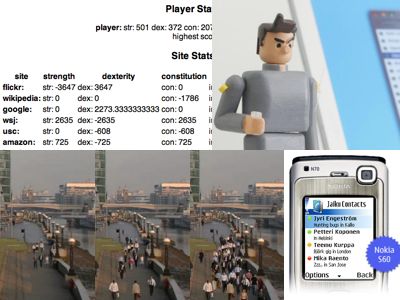
Ubiquitous computing is a couple of decades old and based on the trend towards faster, smaller, cheaper computers. When computation sits in the environment, how do we interact with it? Mark Weiser packaged his approach into something called Calm Technology—a suggestion that to be any good, the computers had better get out of the way.
Or rather, they should move fluidly from the focus of our attention to the periphery and back again with the minimum of fuss. Rather unlike my mobile phone or my IM client which leaps right to my focus by bouncing and shouting regardless of how busy I am or how unimportant the alert is (I speak about this further in my presentation, Engaging Technology).
Passive application sit in the periphery, monitoring the behaviour of ourselves and friends, subtly displaying it back to us. This kind of monitoring is important, as it lets us moderate our behaviour and improve ourselves (I speak more about the consequences of behaviour feedback in Iterative Architecture).
So what applications are there that do this?
Justin Hall’s Passively Multiplayer Online Games sit between you and your web browser, characterising your browsing behaviour as a bunch of stats drawn from role-playing games. If there’s any objective it’s one you set yourselves, but it’s bound to become “be a balanced browser of the web.” I understand from Alice Taylor’s presentation that the BBC are working with Justin to make a prototype of this, to help people “level-up” their browsing.
In the bottom-right is Jaiku, super-powers for your mobile phone addressbook. By each name is shown their availability, location, status message and a bunch of other stuff in the profile. It’s like having peripheral vision of whether a friend is busy or not before you phone them.
The top-right and bottom-left images are project created by my own company. Top-right is Availabot, physical representation of presence in Instant Messenger applications. Availabot plugs into your computer by USB, stands to attention when your chat buddy comes online, and falls down when they go away. It’s a presence-aware, peripheral-vision USB toy.
Bottom-left is another passive display, this time a project we did for Nokia on Continuous Partial Attention. We used ideas from psychology to make a display where alerts would fade in gradually and not disturb you unless you were looking for them—or unless they were super important, in which case the image change would be larger.
Web apps don’t need to be things that you consciously engage with. They can sit in the background, between you and other tasks or ambiently monitoring you and displaying the results. Last.FM have called this myware.
Matt Webb, S&W, posted 2006-09-21 (talks on 2006-09-03, 2006-09-17)